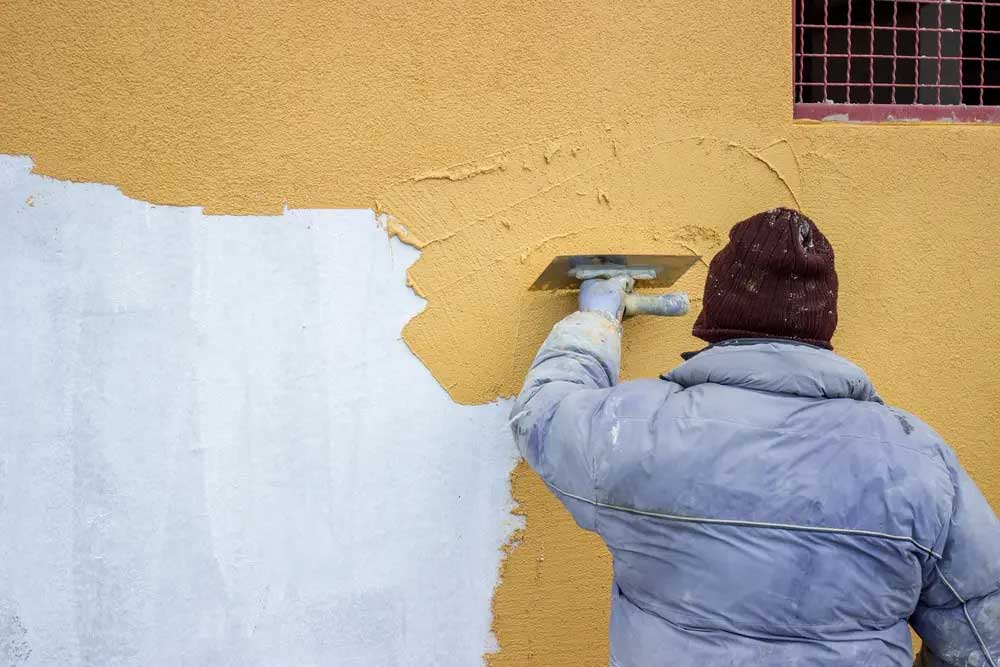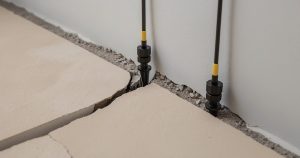Parging vs. Stucco
The complexities and intricacies of stucco and parging often lead to many queries among homeowners. As a leading provider of stucco and parging services in Edmonton, AB, Depend Exteriors is committed to helping you understand these processes in greater depth.
In this stucco vs parging guide, we will demystify these two popular exterior finishes, highlighting their differences, similarities, pros and cons.
Stucco vs Parging Composition and Application: Understanding the Basics
Stucco is a cement-based mortar used as a hardy and aesthetic finish for the exterior of homes. It can be applied to various surfaces, including block, brick, wood, and steel. On the other hand, parging is a masonry mortar used to enhance the exterior wall surface of your home, particularly above-ground foundations.
Let’s dive deeper into the stucco and parging applications.
What is Stucco?
Stucco is a durable and robust material composed of cement, sand, lime, and water, which, when applied to the exterior of a building by experienced professionals, results in a flawless appearance. The stucco mixture is applied in multiple layers over a wire base, also known as lath. Stucco can be painted in various colours based on your preference, enhancing the aesthetic appeal of your property.
There are different types of stucco finishes that can further elevate the elegance of your property. Among these are:
- Cat Face Finish: This unique design consists of a smooth surface with varying sizes of rough areas known as ‘cat faces’. The effect is achieved by applying a rough stucco coat followed by a smooth one, resulting in a stunningly artistic exterior.
- Dash Finish: This popular design offers a textured gravel-like appearance ranging from light to dense texture. It can seamlessly blend with all types of home styles.
- Santa Barbara Finish: This option is excellent for those preferring a smooth finish. Created using small sand particles, this semi-smooth texture is achieved by applying two traditional stucco coats. This finish can be customized with a colour of your choice.
- Sand Finish: Also known as a float finish, this surface appears as though sand has been added to the stucco mixture. Available in fine, medium, or rough styles, sand finishes are perfect for correcting exterior imperfections without compromising the overall look.
- Worm Finish: This unique finish uses synthetic stucco to create grooves on the surface. Although challenging to accomplish, this design can add an interesting visual element to both residential and office exteriors.
What is Parging?
Parging is a masonry technique used to refine and protect the exterior surface of a structure, typically the visible part of a building’s wall foundation or above-ground basement walls. It involves the application of a masonry-based mortar onto masonry or concrete surfaces.
The process usually involves manually applying the coating with a trowel and pressing it into the surface to fill imperfections, resulting in a more level surface. Besides its practical function of protecting the structure against environmental factors like rain, snow, and ice, parging also serves aesthetic purposes by smoothing surface imperfections.
Parging can also be applied to the interior basement walls to enhance structural insulation. However, the parging mix needs to be carefully prepared and applied under suitable weather conditions, with a temperature of at least 5°C for several days, to ensure proper curing. Therefore, it is often recommended to have the parging process carried out by professionals to avoid issues like cracking.
Why Choose Stucco or Parging?
Stucco and parging share several benefits. Both are cost-effective solutions for home exteriors, offering durability across various climates. They also contribute to your home’s energy efficiency by adding insulation.
Regardless of your choice, it’s critical to conduct a professional assessment, considering the local weather conditions and how they could affect your home’s exterior over time.
Pros and Cons: Stucco Vs. Parging
Stucco’s primary advantage lies in its aesthetic versatility. Skilled stucco professionals can create a unique tint that aligns with your home’s design. Meanwhile, parging is a practical way to augment your home’s weather protection. It acts as a barrier against rain, snow, and ice, particularly on above-ground basement walls.
What Are the Advantages of Stucco?
Stucco, a traditional construction material, offers a variety of advantages for homeowners, including:
- Durability: Stucco is known for its long-lasting, hardy nature. It can withstand harsh weather conditions and is resistant to fire and rot, making it an ideal choice for many climates and environments.
- Aesthetic Appeal: Stucco is highly customizable in colour and texture, allowing homeowners to create a unique and attractive exterior finish. Since the colour is often integrated into the material, it tends to fade less over time than other materials.
- Versatility: Stucco can be applied to various surfaces, such as concrete, brick, wood, and steel. It can be applied in various textures and styles to mimic different materials, enhancing its aesthetic versatility.
- Energy Efficiency: Stucco acts as an effective insulator, keeping homes cooler in the summer and warmer in the winter, which can help reduce energy costs.
- Low Maintenance: Stucco requires little upkeep once it’s applied. It doesn’t need to be repainted frequently and can be easily cleaned with a garden hose.
- Noise Reduction: Stucco also offers sound-dampening qualities, which can reduce the level of outside noise that gets into the home.
While these are compelling advantages, it’s important to note that stucco application should be done professionally to avoid potential issues such as water seepage and cracking, particularly in wetter climates.
What Are the Disadvantages of Stucco?
While stucco offers many benefits, it does have a few drawbacks that should be considered:
- Installation: The process of applying stucco can be labour-intensive, which can make it more expensive than other siding materials. It requires several layers and careful application, which requires skill and experience.
- Repairs: Stucco can crack over time, especially in climates with freeze-and-thaw cycles or with ground movement. While small cracks can be repaired, larger ones may require the help of an experienced stucco contractor.
- Moisture Concerns: If not installed correctly, stucco can be susceptible to moisture penetration, leading to mould and rot issues. This is particularly true in wetter climates.
- Difficulty in Modifying: Once stucco has been applied and set, making alterations to the exterior of the house (like adding a new window or door) can be more difficult and may cause cracks in the stucco.
What Are the Benefits of Parging?
Parging has several benefits that make it a popular choice in construction, particularly for masonry and concrete structures. Here are some of its main advantages:
- Protection: Parging provides an additional layer of protection to your walls against water infiltration, harsh weather conditions, and damage from pests or structural impact.
- Improves Insulation: The extra layer can also offer improved insulation, which can help to regulate the temperature within the building and can lead to energy savings.
- Aesthetic Appeal: Parging can cover up imperfections in the construction material, like rough concrete or cinder block, to provide a smoother, more attractive finish. It can be finished in various ways to match the aesthetic of the building.
- Seals Cracks: The process of parging helps in sealing minor cracks and voids in the wall, preventing further deterioration of the wall surface.
- Increased Durability: Parging can enhance the durability and longevity of walls, particularly those exposed to the elements, by providing a barrier against corrosion and wear.
- Cost-effective: While parging requires professional installation for optimal results, it is relatively cost-effective compared to other forms of wall finishing or protection.
However, like other construction processes, parging requires proper installation and maintenance to ensure effectiveness and longevity.
What Are the Disadvantages of Parging?
While parging offers several advantages, it also has a few potential drawbacks. These include:
- Maintenance: Parging may require regular inspections and maintenance to ensure its integrity, as it can crack or peel over time due to weather conditions or foundation shifting.
- Application Skill: Proper application of parging requires professional skills and expertise. Poor application can lead to a less effective protective layer, which could be susceptible to cracks, peeling, or water seepage.
- Aesthetic Limitations: Although parging can help improve the appearance of rough masonry or concrete, it generally offers a more utilitarian finish. There might be better parging alternatives for those seeking a highly decorative or ornate finish.
- Temporary Solution for Structural Issues: Parging is typically used as a temporary solution to address minor cracks and damages. It does not provide a permanent fix for structural issues, which might require more substantial repairs.
- Moisture Trapping: If not correctly applied, parging can trap moisture against the wall, which could lead to dampness and mould growth. Therefore, good quality artistry is crucial to prevent these issues.
Stucco Vs. Parging: A Summary
Parging is a mortar application that’s mainly intended to cover masonry and improve wall surface aesthetics and protection. It doesn’t particularly focus on appearance. On the other hand, stucco is applied to various surfaces to provide a decorative finish.
Stucco is a cement-based plaster used both inside and outside of buildings. It’s low-maintenance, and skilled stucco contractors can use different techniques to enhance its final appearance. Parging, similar to stucco, is applied to cover walls and home exteriors.
While stucco is an older material known for its aesthetic qualities and durability, parging is renowned for providing extra protection against harsh weather conditions. However, whether you choose stucco or parging, it’s crucial to let professional Edmonton builders handle the application. At Depend Exteriors, we understand the importance of making an informed choice when it comes to stucco and parging. Our team of professionals is always ready to provide you with the best advice and service to meet your home’s needs. Contact us today for all your stucco and parging queries or service requirements.
FAQs
You can use acrylic stucco for parging, particularly over concrete foundation walls. However, it’s worth noting that not all concrete foundation walls can effectively be parged using acrylic stucco. This type of parging system comprises the last three layers of Exterior Insulation and Finish Systems (EIFS).
While stucco and parging are made with similar ingredients (cement, sand, and lime), their mixes can differ based on the application. The mix for stucco is often more rigid to withstand weather conditions, while the parging mix is usually smoother for easier application and adherence to the wall.
Parging is a cement coating. It’s typically a mortar mix consisting of cement, sand, and lime applied to a wall for protection and aesthetic improvements.
An alternative to traditional parging can be acrylic stucco finishes. These finishes are typically more flexible and less prone to cracking, making them an effective substitute for certain applications.



